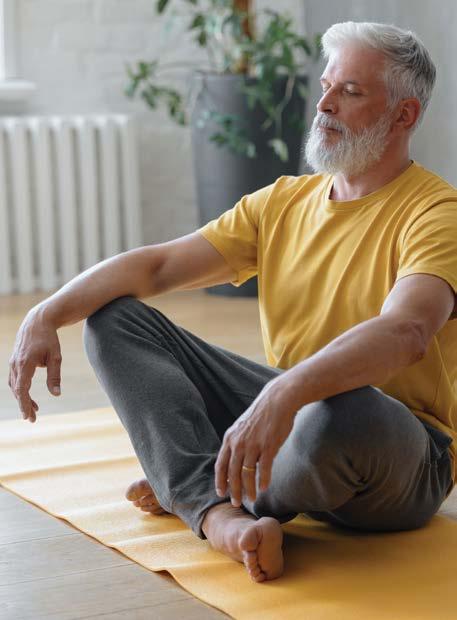
2 minute read
The benefits of meditation For mind and body
BY JONNEMARIE KAHWATY
With the rise of meditation and principles of mindfulness in Western culture comes a plethora of information that can obscure their simplicity and accessibility, as well as their benefits. Practicing meditation and living mindfully can increase mental clarity, reduce stress, and improve mood and concentration. In addition to cognitive benefits, you might also manage chronic pain, lower blood pressure, and even boost immune function, which is particularly beneficial to our health as we age.
Mindfulness is being fully aware and engaged with the present moment. You achieve this through meditation, the practice of bringing full awareness and focus to a single thing. (And yes, you can meditate without sitting on the floor with your eyes closed and legs crossed! More on that later.) It sounds simple until you remember how common multitasking and overstimulation are in today’s world. As you read this, what else is competing for your attention? Are you walking, eating, drinking a cup of coffee? Is the TV on in the background? Are thoughts floating in the back of your mind about what you’re going to do once you’re done reading? Take a moment to let everything else go and focus your attention to this one task, without distraction. It may feel difficult and uncomfortable at first, but that’s perfectly normal…that’s why we call it a practice!
What can this practice look like for you? It could involve passive meditation—the classic eyes closed, seated posture visual that probably popped into your head—which is the easiest way to start because by closing your eyes to the outside world, you eliminate distraction and facilitate your mind’s ability to focus inward. With practice, it becomes easier to stay present.
One of the biggest misconceptions about passive meditation is that the goal is to “clear your mind.” People try once, experience a random thought, and give up thinking they failed. It’s natural for your mind to wander. As mentioned earlier, choose one thing to focus on while you’re meditating. Breath is common, but it can be a body part, mantra or emotion. If sitting cross-legged isn’t comfortable, find a different position; discomfort is a distraction.
During meditation, the goal is not to shut down thoughts, but to observe them. You may have an urge to follow them and shift your attention, but the key is to acknowledge the thought for what it is—just a thought—accept it without judgment and refocus. Continue this process as thoughts, feelings, and sensations come up during your practice.
If you feel overwhelmed, remember this is a practice. Think of yourself as sorting through a filing cabinet that hasn’t been touched in years—there are going to be a lot of files! Be patient and kind to yourself. Starting with even a few minutes daily can be incredibly effective.
Once your mind has been trained, you’ll start to practice active meditation more naturally as well. Active meditation is just that—meditation in motion! Instead of meditating while sitting and doing nothing else, you find meditative moments throughout your day. Some people find it less intimidating to focus on common activities like cooking, cleaning, eating, walking, or showering. Mindful eating can aid with digestion.
Start by eliminating intentional distractions that normally accompany these activities. If you normally eat dinner while watching TV or scrolling your phone, eat without devices. If you have earbuds in while walking or cleaning, perform these activities in silence. Take advantage of the stillness to focus attention on your actions and bring awareness to your senses one by one. Observe colors, shapes, and textures of ingredients as you cook. Notice the sound of the broom sweeping against the floor. It might feel weird at first, but as you continue your practice, tuning into your senses will become second nature.
Everyone has mindfulness; we just have to learn to access it. Meditation is not one-size-fits-all so it’s important to find a practice that feels comfortable and sustainable for you. It may take time to develop a consistent practice, but the benefits are worth it.
Jonnemarie Kahwaty is a dance instructor, musician, and herbalist with a passion for holistic health and wellness.







